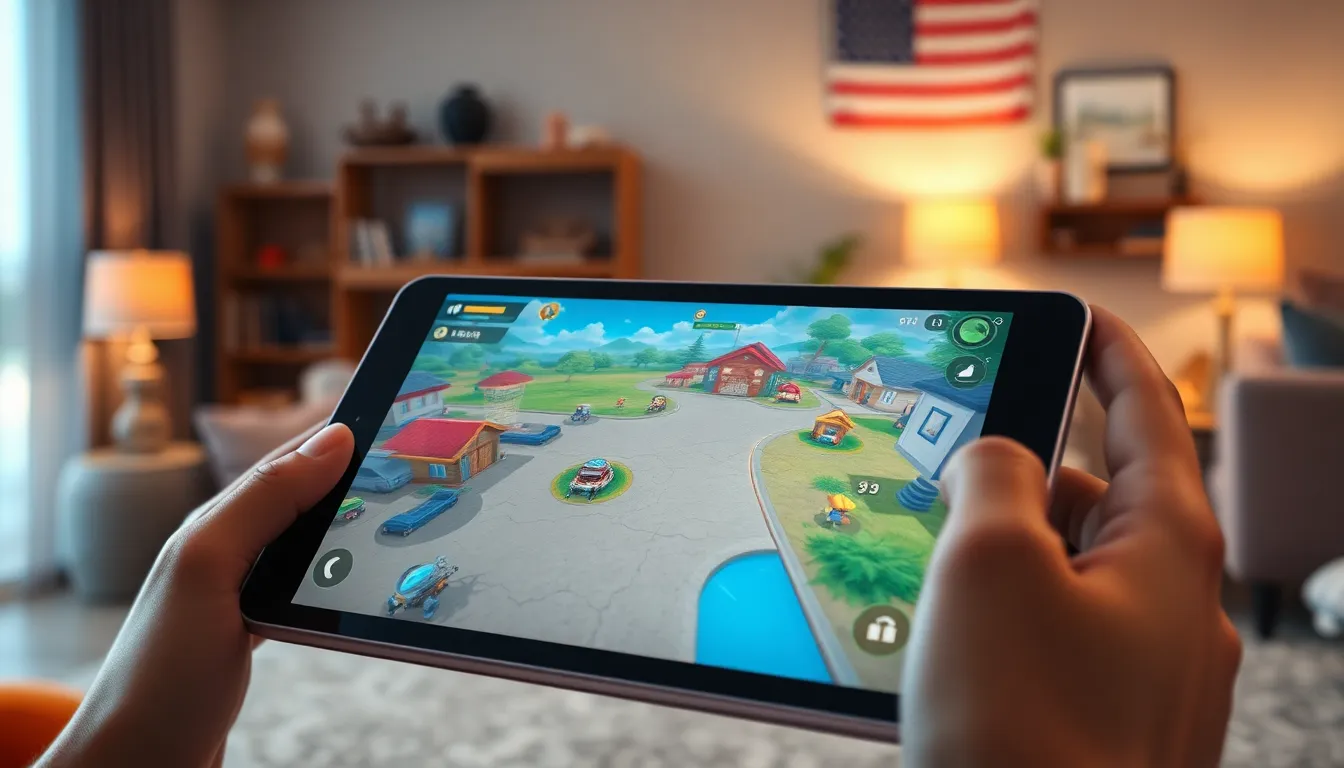Table of Contents
ToggleIn a world where gaming knows no bounds, tablets have emerged as the unsung heroes of portable entertainment. Gone are the days when gaming was confined to bulky consoles and high-end PCs. Now, with just a swipe of a finger, players can dive into immersive worlds right from their laps. But wait—how does tablet gaming performance stack up against traditional systems?
Imagine battling dragons while waiting for your coffee or racing through virtual landscapes on your lunch break. It sounds like a dream, right? Yet, not all tablets are created equal. Some might struggle under the weight of high-octane graphics while others soar with effortless speed. Join the exploration of how to unleash the full potential of tablet gaming and discover which devices can handle the heat without breaking a sweat.
Overview of Tablet Gaming Performance
Tablet gaming performance varies significantly among devices, driven by factors like processing power, graphics capabilities, and optimization. Consider processing units, as they dictate how smoothly games run. High-performance tablets utilize advanced processors, such as Apple’s A-series or Qualcomm’s Snapdragon, providing seamless gameplay experiences.
Graphics can also impact performance. Tablets featuring high-resolution displays and dedicated GPUs handle demanding titles better than those with basic specifications. Users should note that game developers often optimize their titles for specific hardware, maximizing the experience based on available resources.
Memory plays a crucial role too. Devices equipped with sufficient RAM can multitask efficiently, letting users switch between games and apps with ease. Most modern tablets come with 4GB to 8GB of RAM, which meets the majority of gaming needs adequately.
Battery life remains a pivotal concern in gaming performance. Tablets with larger batteries offer longer play times but may require heavier power management strategies during intensive gaming sessions. Users who’ve experienced lag or crashes might benefit from optimized power settings or keeping devices charged.
Connectivity options matter as well. Tablets with robust Wi-Fi and Bluetooth capabilities support multiplayer features and online gaming experiences effectively. Variability exists, so users should research specific models known for superior connectivity.
Assessing tablet gaming performance requires an understanding of several components, including processing power, graphics, memory, battery life, and connectivity. Observing these attributes leads to better device choices and enhances the overall gaming experience.
Key Factors Influencing Performance

Tablet gaming performance relies on several critical factors. Understanding these components can significantly enhance gaming experiences.
Processor Capabilities
Processor capabilities play a vital role in gaming performance. High-end processors, such as Apple’s A-series and Qualcomm’s Snapdragon, offer superior speeds and efficiency. Tablets with these processors manage demanding games with ease, ensuring smooth operation. In contrast, lower-end processors may struggle or lead to lag during high-intensity gameplay. Effective thermal management also contributes to sustained performance, preventing slowdowns during extended sessions.
Graphics Performance
Graphics performance directly impacts visual clarity and realism in games. Tablets equipped with advanced GPUs provide better rendering, enhancing the overall experience. Games with high-resolution graphics require powerful graphics hardware to run smoothly. Models featuring displays with vibrant colors and sharp resolutions elevate immersion. Graphics optimization also matters, as developers tailor performance to fit hardware specifications, ensuring seamless gameplay across various devices.
RAM and Storage
RAM and storage capacity influence multitasking and game loading times. Tablets featuring 4GB to 8GB of RAM typically deliver smoother experiences, allowing multiple apps to run simultaneously without hiccups. When it comes to storage, adequate space is essential for installing large games and updates. SSD storage options enhance loading speeds compared to traditional HDDs. Sufficient RAM and storage together support demanding titles and provide a more enjoyable gaming experience overall.
Popular Tablets for Gaming
Tablets offer a range of options for gamers seeking performance and portability. Selecting the right device enhances the gaming experience significantly.
High-End Models
Apple’s iPad Pro stands out with its powerful A-series chip, delivering exceptional graphics and smooth gameplay. Many gamers appreciate the vivid Liquid Retina display, which supports stunning visuals, making it ideal for immersive gaming sessions. Samsung’s Galaxy Tab S8 also excels with its Snapdragon 8 Gen 1 processor, providing efficiency and excellent rendering capabilities. Both tablets feature up to 16GB RAM, allowing for seamless multitasking while gaming. The advanced connectivity features, such as Wi-Fi 6, further enhance online gaming experiences.
Budget-Friendly Options
The Amazon Fire HD 10 offers great value for casual gamers. Its 10.1-inch display and decent performance make it suitable for lighter gaming titles. Many users find the tablet efficient for streaming games and casual gameplay, especially at its competitive price point. Another option, the Lenovo Tab P11, provides strong performance with its Snapdragon 662 processor, enabling a good gaming experience without breaking the bank. The device includes 4GB RAM, which suffices for most casual gaming applications. Overall, budget tablets can still deliver enjoyable experiences for everyday gaming needs.
Gaming Experience on Tablets
Tablet gaming offers an impressive experience that merges portability with powerful performance. Players can enjoy a range of games anywhere, making the tablet an appealing choice for low-key gaming sessions.
Touchscreen Responsiveness
Touchscreen responsiveness significantly impacts gameplay quality. A higher touchscreen sampling rate enhances accuracy and reduces latency, thereby providing smoother controls during intense gameplay. Tablets with advanced touchscreen technology allow for faster reaction times, essential for competitive gaming. High-end models typically feature more sensitive displays that better respond to gestures and commands. This responsiveness creates a more immersive experience, enabling gamers to perform actions more effectively. Players notice improved engagement with fast-paced titles when using tablets equipped with superior touch technology.
Battery Life
Battery life proves critical for uninterrupted gaming sessions. Many gaming tablets come equipped with larger batteries, allowing hours of playtime without needing a recharge. Effective power management features help maintain performance during demanding gaming scenarios. Tablets boasting battery capacities around 8000 mAh or higher can support extended gaming without sacrificing performance. Players appreciate models with fast-charging capabilities, ensuring minimal downtime. Long-lasting battery life enhances the overall gaming experience, enabling users to focus more on gameplay rather than seeking a power outlet.
Future Trends in Tablet Gaming
Tablet gaming is evolving rapidly, driven by technological advancements and a growing library of games. These trends position tablets as competitive options in the gaming market.
Advancements in Technology
Processing capabilities continue to improve, with each new generation of processors like Apple’s M-series and Qualcomm’s Snapdragon offering enhanced performance. These advancements lead to faster load times and smoother graphics rendering. Integration of advanced graphics APIs, such as Vulkan, allows developers to create visually stunning experiences without sacrificing performance. Speedy wireless connections, including Wi-Fi 6, enhance online play and reduce latency. Manufacturers increasingly prioritize battery technology, optimizing power usage for longer play sessions even during high-demand gaming. Innovative cooling solutions further maintain device performance, ensuring tablets run optimally during intense gaming sessions.
Increasing Game Availability
The expansion of game libraries on tablets reflects a growing recognition of these devices in the gaming ecosystem. Major developers are now creating more titles specifically for tablet platforms, catering to a diverse audience of casual and hardcore gamers alike. Cross-platform gaming features allow players to compete with friends on different devices, increasing user engagement. Streaming services like Xbox Cloud Gaming and NVIDIA GeForce NOW enable access to console-level games directly on tablets, further broadening game availability. Regular updates from developers ensure that existing games remain optimized for the latest hardware, enhancing gameplay experience. A larger selection of games contributes significantly to the vibrant tablet gaming community.
Tablet gaming is rapidly evolving as a versatile platform that caters to both casual and serious gamers. With advancements in processing power and graphics capabilities, today’s tablets can deliver impressive performance comparable to traditional gaming systems. Users benefit from the convenience of gaming on the go while enjoying a range of options that fit their needs and budgets.
As technology continues to improve, the gaming experience on tablets is set to become even more immersive. Gamers can look forward to enhanced graphics, faster load times, and a growing library of games optimized for mobile devices. By understanding the key features that influence performance, players can make informed choices to elevate their gaming adventures.







